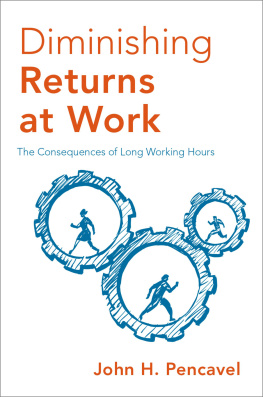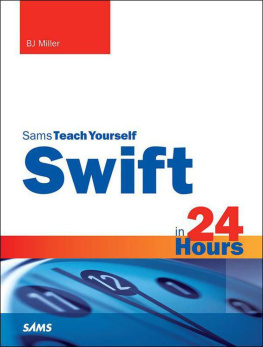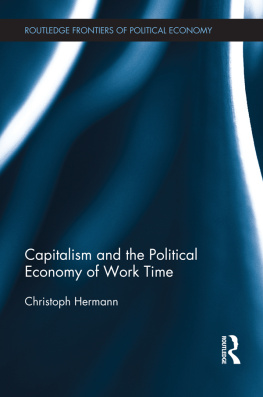DIMINISHING RETURNS AT WORK

Oxford University Press is a department of the University of Oxford. It furthers the Universitys objective of excellence in research, scholarship, and education by publishing worldwide. Oxford is a registered trade mark of Oxford University Press in the UK and certain other countries.
Published in the United States of America by Oxford University Press
198 Madison Avenue, New York, NY 10016, United States of America.
Oxford University Press 2018
All rights reserved. No part of this publication may be reproduced, stored in a retrieval system, or transmitted, in any form or by any means, without the prior permission in writing of Oxford University Press, or as expressly permitted by law, by license, or under terms agreed with the appropriate reproduction rights organization. Inquiries concerning reproduction outside the scope of the above should be sent to the Rights Department, Oxford University Press, at the address above.
You must not circulate this work in any other form and you must impose this same condition on any acquirer.
Library of Congress Cataloging-in-Publication Data
Names: Pencavel, John H., author.
Title: Diminishing returns at work : the consequences of long working hours / John H. Pencavel.
Description: New York : Oxford University Press, 2018.
Identifiers: LCCN 2017052160 | ISBN 9780190876166 (hardback) | ISBN 9780190876173 (UPDF) | ISBN 9780190876180 (epub)
Subjects: LCSH: Hours of laborUnited States. | Hours of laborGreat Britain. | WagesUnited States. | WagesGreat Britain. | Labor productivityUnited States. | Labor productivityGreat Britain. | Industrial hygieneUnited States. | Industrial hygieneGreat Britain. | BISAC: BUSINESS & ECONOMICS / Labor. | BUSINESS & ECONOMICS / Workplace Culture. | BUSINESS & ECONOMICS / Corporate & Business History.
Classification: LCC HD5124 .P46 2018 | DDC 331.25/70941dc23
LC record available at https://lccn.loc.gov/2017052160
This book is dedicated to my American and English families.
Contents
I have conducted research on working hours for years. Over these years, I have received help from many peoplestudents, colleagues, researchers, refereesin the form of constructive criticism, of collaboration in the research, and of data collection and statistical analysis. I thank them for their help. I thank Louise Pencavel and Norma Virgoe, who made significant contributions to this book.
This book stems from articles that I have written in recent years and that are listed in the references. Although some of the observations here have been used in previous work, none of the equations specified in has appeared elsewhere. All were calculated by Katy Bergstrom, an outstanding research assistant. I thank her for her work.
Research support from the Russell Sage Foundation (Award #: 85-16-05) is acknowledged with thanks.
I also acknowledge those scholars who have expressed (at least implicitly) many of the arguments presented in this book. An incomplete list is .
My editor at Oxford University Press, David Pervin, shepherded the manuscript as it passed through its various stages, and he supported its preparation. Thank you.
DIMINISHING RETURNS AT WORK
A common gauge of an individuals material standard of living is his or her income or consumption over a period of time. Measuring an individuals well-being in this way neglects the means by which this income or consumption has been obtained. Yet, for most people, income is acquired by selling their time and lending their efforts to someone else. Part of this time and energy may not be entirely unpleasant, but many would prefer to spend less time in this way, even if it entails lower income.
Among those with the same income or consumption level, the individual who works longest for that income would be judged by many as having the lowest well-being. This judgment helps to explain why some societies have applied a higher tax rate to nonlabor income than to labor income. Thus, the hours that people work in labor markets are linked to their standard of living.
Working hours also matter to employers, as testified by their willingness to spend resources to resist any reductions in hours worked by their employees. The employer determines the work schedule for employees. The manner in which these working hours (together with other inputs) generate an output is embodied in the firms production function. It is often assumed the employer has complete knowledge of the production function in the workplace, although the history of working hours might cause one to question this assumption.
The production function is one of the basic constructs of economics. It describes the manner in which factors or inputs (such as land, labor, raw materials, and physical capital) are converted by an organization into one or several outputs. This monograph is concerned with the input of labor in production and, in particular, with the input and consequences of hours of work.
The marginal product of working hours in a production function may be defined as the change in output as a result of an additional hour of work, when all other inputs are fixed. When working hours are useful in producing output, an additional hour worked (when other inputs are constant) does not cause output to fall; more likely output will rise. So, normally, the marginal product of working hours is positive.
Usually economists assume that the marginal product of any input is not a fixed number, that it varies with the level at which other inputs are used. Also, the marginal product of an input is assumed to vary as additional units of that input are applied in production. In particular, the law of diminishing returnsone of the basic postulates of economicsconcerns the change in the marginal product of an input as more of that input is used. Applied to working hours per worker, the law of diminishing returns states that, provided all other inputs are constant, as hours of work increase, after a certain level of working hours the marginal product of hours falls. It is the marginal product of hours that lies behind the firms demand for hours of work in orthodox models of the purposive firm; that is, according to the law of diminishing returns, after a certain number of hours, the marginal product of hours per worker falls as the number of hours increases and, correspondingly, the demand for hours per worker falls as the number of hours increases.
provides an account of the role of the law of diminishing returns in economic thought. In addition, the law of diminishing returns is relevant for assessing the consequences of mandatory reductions in working hours.
Not only have economists overlooked the need to confirm the law of diminishing returns as applied to working hours, but also there has been an unwitting tendency to assume it does not apply. For instance, much of what has gone under the name of labor supply analysis in the past forty years or so has unthinkingly assumed that diminishing returns to hours of work do not operate; this will be shown below. If the law of diminishing returns does apply to working hours, then the usual procedures followed by economists to account for differences in the hours of work among individuals are questionable. This topic is taken up in .
It will soon become clear that much of the research described herein is comparative. Information defined by its time and place is often better digested when contrasted with the analogous information at another time or in another place. This is certainly the case for the empirical work I discuss in the chapters that follow. I concentrate on the two societies I know best: Britain and the United States of America (referred to in the text simply as America), so there is an explicit geographical dimension to the research presented. In addition, there is a clear historical dimension in that I draw upon information about working hours in the past, as well as those in the present.









